Holland
Cliquez ici pour la version franŤaise
During September 1944 the invasion of southern Holland had been planned. With the speed at which the Germans had been cleared from France, the Allied airborne forces that were originally intended to leapfrog front lines in a rolling pattern were faced with constant operations being cancelled. The German withdrawal and pace of General Patton’s race across France caused a number of airborne operations to be cancelled causing frustration and dismay at the alternative strategies being rushed into place. Operation LINNET scheduled for 3rd September was one such example and was in effect a forerunner of Operation Market Garden where the 1st Allied Airborne Army (comprising of US 82nd and 101st Airborne Divisions, British 1st Airborne Division and the Polish Parachute Brigade) would drop into Tournai. However, it was cancelled as the town fell the night before the operation was due. SHAEF had to contend with Montgomery’s jealousies and rages while trying to execute strategies, which would result in the final invasion of Germany through southern Germany in the Aachen area.
In the planning for Operation Market Garden the 1st Polish Armoured Division command was transferred from the II Canadian Corps to the I British Corps of the 1st Canadian Army. Part of Antwerp and the river Schelde were under Allied control and the right flank saw the 2nd British Army forcing a wedge into the front lines just below Nijmegen. The 1st Canadian Army was ordered to clear the southern Holland and open the port of Antwerp. The opening of Antwerp was vital to improve supply of front line units since the lines of supply stretched all along the Channel Ports to Cherbourg.
While the ill fated Operation Market Garden wore on to the north and finally collapsed on 26th September, the 1st Polish Armoured Division were in operations around Tilberg and Breda. Action started with the crossing of the Antwerp – Turnhout Canal on 29th September with the goal of capturing Merxplas. The soft terrain was criss-crossed by dykes and defences along the Wolfsputten – Merxplas axis was strong and required 10 PSK to fight hard throughout the engagement, which resulted in prisoners being captured and ordinance destroyed. The battle to cross the Dutch frontier was fierce in a terrain not suited to armoured corps and the narrow roads caused congestion enabling well place German artillery and mortars in woods to keep units pinned down or moving slowly. By early October General Maczek was ordering cessation of engagements to allow artillery barrages or aerial bombardments by Typhoons and Spitfires to dislodge the enemy.
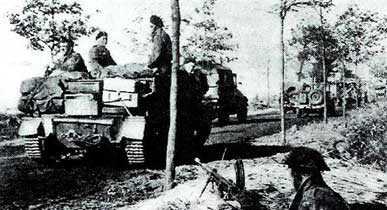
On 4th and 5th October 1944 1st Polish Armoured Division held the Merxplas – Baarle-Nassau – Alphen axis with the Germans retreating into the woods behind Alphen after a ferocious battle. German documents captured on the frontline showed surprise tactics and Poles operating in areas least expected had caught the Germans off-guard (McGilvray, 2006).
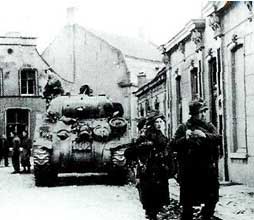
On 5th – 6th October 1944 10 PSK under orders to initially move 1 Km north of Baarle-Nassau to protect action around Barrle-Boschoven where the well defended town had hampered the infantry. By late afternoon 10 PSK had broken through and with artillery barrage breaking resistance entered the town from the west and again surprised the retreating Germans. Infantry cleared the town while 10 PSK sent out reconnaissance patrols to secure the eastern and western outskirts of the town and now secured the important Baarle – Nassau junction. It was estimated that the 1st Polish Armoured Division faced two battalions of infantry supported by artillery and a large number of anti-tank guns. While various units spent their time securing the area, some like the 1st Squadron were sent on support missions to British actions nearby over the next few days.
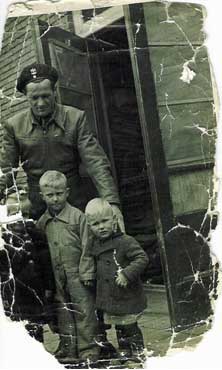
Photo kindly lent by Mr Gilles Leppers who is seeking further information about the location and people in the picture.
The action to capture Breda started on 27th October when the Division launched its attack under the cover of thick fog around Alphenschedijk. 10 PSK suffered casualties around Vijhuizen while the 2nd Squadron made a dash for Gilzen (Gilze-Rijen) to close an escape route and capture the airfield and secure flanks towards Tilburg (McGilvray, 2006). (317 Wilno Fighter Squadron were based here from March until April 1945 followed by 305 Bomber Squadron was based here from 7th September until late October 1945 using the airfield as a forwards operations base).
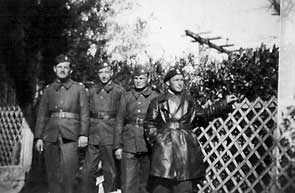
Photo kindly lent by Mr Gilles Leppers.
Over the next two days the Division was trying to support the 4th British Armoured Brigade around Rijen to the west of Breda and the 2nd Canadian Armoured Brigade just north of Ginneken on the southern outskirts of Breda. With the 104th Infantry Division capturing Rijbergen just to the east of Breda, the city was becoming encircled. A German counter-offensive became a major threat to the stretched ‘front’ where road quality and dyke patterns almost dictated military offensives. With enemy units fighting now in the rear of the 10 PSK, the capture of Dorst enable the front to be secured. While a counter attack caused delay, the city was entered on 29th October by 8th Rifle Battalion (8 Batalion Strzelców) who were engaged in intense street fighting where bunkers and well positioned mortars, anti-tank guns and machineguns needed to be cleared in house to house fighting. Tank support was called in to clear the districts systematically. At times the intensity of battle was ferocious with troops using grenades to clear cellars and dodging deadly sniper fire. There were to high casualty rates to both sides and despite local damage to property, there were no civilian casualties.
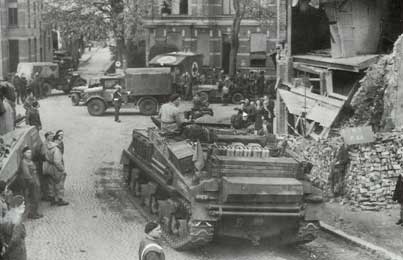
From 30th until 31st October 1944 the Division was in ‘mopping-up’ operations to the north of the city around Beek and capturing the strategic bridge over the river Mark. Counter attacks slowed progress and although mechanized units from 10 PSK were able to shell positions and columns, the German field of fire prevented the blown bridge to be rebuilt and many Polish units faced not only exhaustion, but also lack of ammunition.
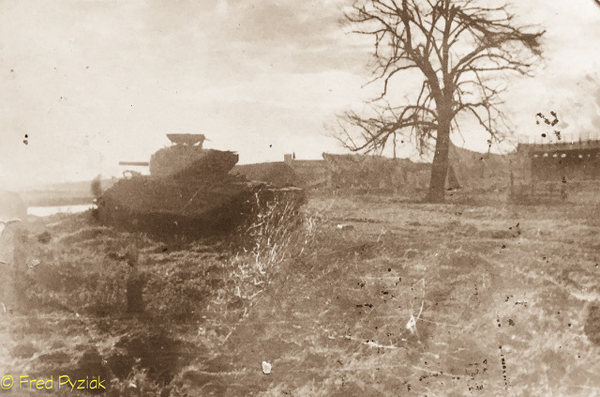
The photo has ben kindly lent by the Pyziak family and shows LCPL Jan Pyziak Sherman Firefly tank on the bank of the Mark canal probably around 31st October 1944 when 8BS crossed the canal under artillery support to form a bridgehead where enemy artillery, mortar and self-propelled guns turned the crossing into hell due to the extent that sappers and infantry could not advance to secure it. The bridgehead was temporarily abandoned due to shelling and counter-attacks by the Germans. On 3rd November 1944 a formation of 10BK panc successfully crossed the canal to form the bridgehead in one of the closing actions of their campaign in Holland.
Once a strong bridgehead had been built up the Division crossed the Mark canal on 3rd November and headed for a break through to Moerdijk where the Germans had flooded the marshes to slow the tank columns with operations ceased on 9th November 1944. The terrain had been an operational nightmare for the ‘tankers’.
Ardennes Offensive
Battle of the Bulge 16th – 19th December 1944
‘The Ardennes offensive, launched on 16th December 1944, intoxicated Hitler loyalists with revived morale. The tables had at last turned. Belief in the Führer and in the Wunderwaffen, the miracle weapons such as the V-2, blinded them to reality’ Beevor (2002:5)
Hitler’s counter attack had been planned in the autumn of 1944 with the intent of re-capturing Antwerp and driving a wedge between the Allied ground forces, which would also have political ramifications through de-stabilizing the alliance whose generals were divided in opinion on the assault on Germany (Hastings, 2005). At mid-winter the poor weather and lack of fighter support coupled to a terrain covered in snow left the Ardennes in a mode of a stagnant defensive front. Locals had provided military intelligence with evidence of a military build-up and few ‘sorties’ by Allied air forces reported unusual amounts of ‘flak’ prior to the launch of the offensive (Ambrose, 2002).
For 1st Polish Armoured Division the rest from front line activity was a welcomed, but weather conditions and the billeting were not ideal. Both the Poles and Canadians were defending a complex network of canals and rivers on the Maas. On the opposite bank was a series of well dug in defensive positions of the 711th and 712th Infantry Divisions. At the launch of the Ardennes offensive, the Poles were placed under 1st Canadian Army with expressed orders to meet any airborne or counter-offensive along a 50Km front and were supported by 47 Royal Commando and 1315 RAF Regiment in locations recently vacated by Canadian 4th Armoured Division. Patrols went on skirmishes to keep up pressure on the German defensives around Walwijk, but conditions were poor with troops lying in straw-lined ditches or luckier ones in farm buildings. While no Polish units were ‘active’ during the Ardennes offensive, they formed a vital defensive chain keeping opposing forces pinned down. However, the following engagement has a far greater significance now than previously thought.
Kapelsche Veer Operation
Kapelsche Veer Operation has been described by a number of historians as ‘the battle, which should have not been fought’. However, on the German banks of the Maas, the small ferry-port had a far greater significance than previously thought. The area was to be used as a bridgehead to support the Ardennes Offensive. Operation Fall Braun was to support the main thrust of the Ardennes Offensive in a dash to capture Antwerp and drive a wedge through the Allies extended supply lines. The bridgehead was a heavily defended complex built on an island and mainly made up of the German 6th Parachute Division containing a significant number of ‘raw’ troops. The German 6th Parachute Division was under the command of General Student Army Group ‘H’. The German position was weakened by shortages for the main offensive in the Ardennes and troops were pulled from the line for re-supply on the basis that the fort at Kapelsche Veer was almost impregnable. Polish field intelligence indicated the area and strength of the German forces posed as a threat of counter-attack and needed to be secured and could not be bypassed.
On 31st December 1944 under the command of the 3rd Polish Infantry Brigade (3 Brygada Strzelców) a platoon from the 1st Squadron engaged the enemy in the first phase of clearing the islands between the Oude Maasje canal and the Maas River without success other than clearing German patrols from nearby land (McGilvray, 2006). In an extended operation launched on 3rd January 1945 10 PSK went into action with the 1st Squadron attacking Kaatsheuvel and 2nd Squadron moving towards Walwijk with 3rd Squadron operating near Henstraat where a river crossing with the objective of capturing S’Hertogenbosch. The 1st Polish Armoured Division would support and re-enforce the 47 Royal Commando and a Canadian battalion (Barbaski, 1982).
Again on 7th January action continued in this sector as the German bridgehead was well dug in and heavily defended by a few well-positioned artillery and anti-tank units. Again the attack stalled. 47 Commando attacked on 13th to 14th January and did not fare much better. It was not until the extremely tough Canadian operation from 26th January until 1st February 1944 saw the area cleared.
The Finale
The Division had been ‘pulled from the line’ and moved to Tetringen until 4th March 1945 where it rested and trained while awaited fresh orders. On 5th March the 10 PSK was moved to the Raamsdonkveer and Raamsdonk area to defend the Maas in a ‘holding’ operation and supported by Dutch troops (Engelbert and Barbarski, 1992, McGilvray, 2006). The division re-engaged the enemy on 7th April 1945 in an attack towards Emmen. Since January 1945 the Eastern front had seen Soviet forces push through Poland leaving a constricting enclave at Könisberg and the German merchant fleet and navy attempted to evacuate over 2 million refugees (Hastings, 2004). In the Italian theatre the 2nd Polish Corps was approaching Solaro while the Allies were crossing the Rhine into southern Germany in a push for Berlin.
The 1st Polish Armoured Division had been placed under the Canadian II Corps (Infantry) to attack Goch and then strike out towards Coevorden where General Maczek believed the Germans were amassing for counter attacks. The march to the jump-off point at Goor and Coevorden was long and weary with tanks being disembarked from transporters to confuse the enemy. While the initial assault area was lightly defended, the flooded marshes slowed the advance towards Emmen. Enroute the 1st Squadron liberated a concentration camp at Westerbork.
On reaching the Oranie canal near Emmen the 10 PSK split with 1st Squadron attacking Odoorn while the other units were assigned individual targets and tasks. By 12th April 1945 10 PSK were in clearing operations to secure the area between Emmen, Odoorn and Exlo. While they continued to meet resistance and well defended bridges and towns, the Poles inflicted heavy casualties on the enemy. Between 13th until 18th April 1945 were in action between Buinen and Veendam with units linking up with the 3rd Canadian Infantry Division at Gieten. During this period General Maczek kept the momentum up and pressure on the enemy where units were moved and integrated or amalgamated with others to optimise firepower and their mechanized options and not remain static in their bid to capture the naval base at Wilhelmshaven. On 17th September the Division sent an armoured platoon to Stalag VIC to protect 1700 women prisoners from Warsaw Uprising from German reprisals. Clearing operations continued west of the river Ems towards Walchum and Heede as there were reports of roving SS bands in the area.
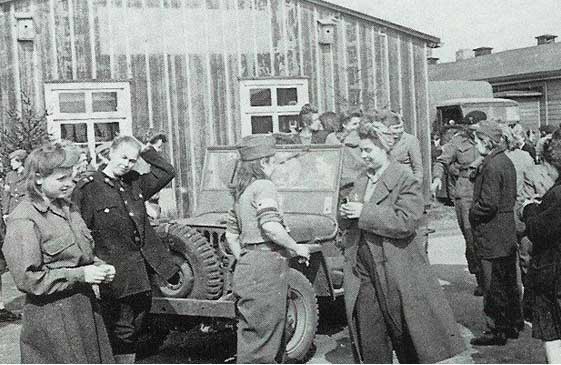
On 20th April 1945 the whole division was in clearing operations around Papenburg with 10 PSK being led by Lieutenant-Colonel Nowaczynski. After reaching the Kusten Canal near Neulehe the Poles liberated another concentration camp, but Allied bombing had severely damaged the camp and some prisoners were being held in the marshes for protection. 8th Rifle Battalion (8 Batalion Strzelców) was dispatched with tanks and Bren-gun carriers to rescue the prisoners. German prisoners were later put to use repairing the damaged roads (Engelbert and Barbarski, 1992, McGilvray, 2006). Minor operations continued ‘mopping up’ in and around the marshes.
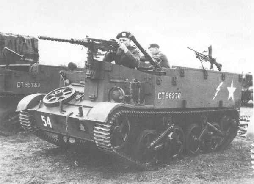
Brenn carrier
From 24th until 25th April action centred on Idafen where the area had already been cleared of a German Marine Infantry Division had now been replaced by a Parachute battalion. 8th Rifle Battalion covered by the 2nd Squadron took Idafen with ease and moved north with the 2nd Squadron attacking Strucklingen and shelling positions between Bollingen and Ramsloh before heading towards Scharrel. 29th April was the Regimental Day and a period of rest and remembrance for fallen comrades with a visit from General Maczek.
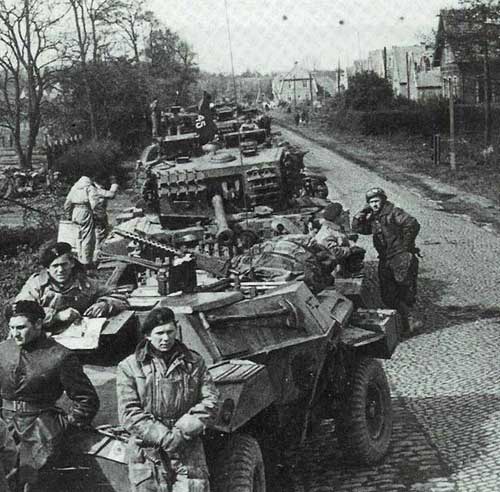
Awaiting orders before entering Leer.
On 1st May 1945 the Division was on the move towards Leer moving north along the Dutch – German border, but due to such damage to the roads, which were also no longer suitable for tanks, commanders made improvisations to their plans to keep their advance towards Schwerinsdorf and Grossoldendorf underway. Here they caputered many prisoners and captured communications and artillery magazines. The 2nd Squadron captured a bridge almost intact and crossed the river Ehe and continued north towards Remels and their speed caught the German defenders off-guard and despite localized skirmishes supported by accurate artillery fire broke resistance and Remels fell on the night of 2nd – 3rd May. 10 PSK captured Moorburg, Hellweg, Westerstedde and Halsbeck to the southeast of Remels.
On 4th May 1945 the 3rd Squadron met up with the 1st Tank Regiment at the small village of Halsbeck in preparation for another assault on the German lines on the outskirts of Wilhelmshaven. Before they could assault Wilhelmshaven or start any further action, Germany capitulated on 5th May 1945.
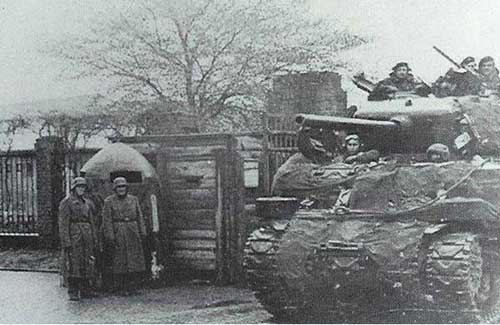
|
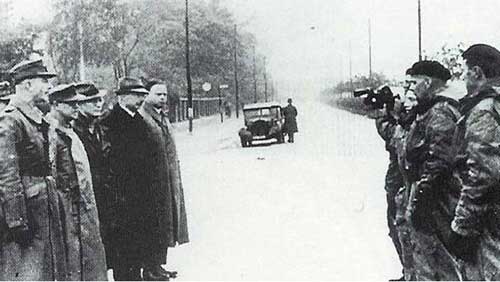
|
|
Entering the naval base
|
Capitulation 5th May 1945
|
General Maczek accepted the surrender of the base almost intact with:
- 19,000 prisoners (included 2 Admirals and 1 General)
- 3 battle cruisers
- 18 submarines
- 205 minor warships and support vessels
- 94 fortress guns
- 159 field guns
- 64 million rounds of carbine ammunition
- Food for 50,000 troops
The 1st Polish Armoured Division (Black Devils) remained part of BAOR with the Polish Parachute Brigade until 1947 when it was disbanded and the troops placed in the Polish Resettlement Corps.
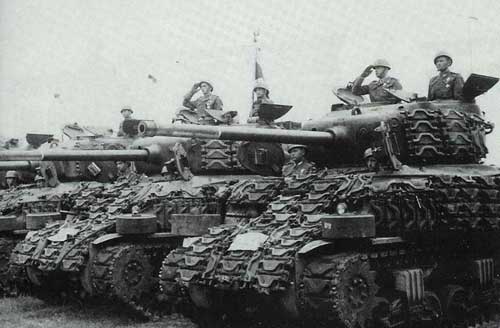
The last parade
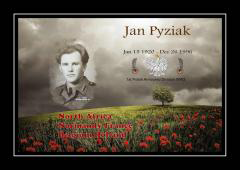
Some useful web resources:
www.classicbuffalo.com/VeteransCzyz.htm
www.classicbuffalo.com/images/FirstPolishArmorDivision.jpg
www.waramps.ca/military/wwii/aaod.html#south
The March to Germany
Top of Page
|